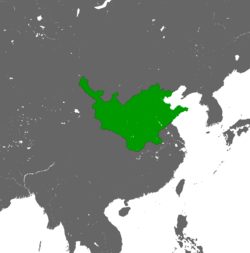Shun dynasty
Great Shun Đại thuận | |||||||||||
|---|---|---|---|---|---|---|---|---|---|---|---|
| 1644–1646 | |||||||||||
 The Shun dynasty at its peak in 1644 | |||||||||||
| Status | Short-lived dynasty of China | ||||||||||
| Capital | Xi'an (1644) Beijing (1644 – 5 June 1644) | ||||||||||
| Common languages | Chinese | ||||||||||
| Religion | Buddhism,Taoism,Confucianism,Chinese folk religion | ||||||||||
| Government | Monarchy | ||||||||||
| Emperor | |||||||||||
• 1644–1645 | Li Zicheng | ||||||||||
• 1645–1646 | Li Zijing | ||||||||||
• 1646 | Li Guo | ||||||||||
| Historical era | Transition from Ming to Qing | ||||||||||
• Established inXi'an | 8 February 1644 | ||||||||||
• CapturedBeijing/Death of theChongzhen Emperor | April 1644 | ||||||||||
• Proclamation as the Yongchang Emperor | 3 June 1644 | ||||||||||
• Fall ofBeijing | 5 June 1644 | ||||||||||
• Surrender to the Southern Ming | 1646 | ||||||||||
| Currency | Chinese coin,Chinese cash | ||||||||||
| |||||||||||
| Today part of | China | ||||||||||
| Part ofa serieson the |
| History of China |
|---|
TheShun dynasty(simplified Chinese:Thuận triều;traditional Chinese:Thuận triều;pinyin:Shùn cháo), officially theGreat Shun(simplified Chinese:Đại thuận;traditional Chinese:Đại thuận;pinyin:Dà Shùn), also known asLi Shun(simplified Chinese:Lý thuận;traditional Chinese:Lý thuận;pinyin:Lǐ Shùn), was a short-livedChinese dynastythat existed during theMing–Qing transition.The dynasty was founded inXi'anon 8 February 1644, the first day of the lunar year, byLi Zicheng,the leader of a largepeasant rebellion,by proclaiming himself "emperor"(Hoàng đế) instead of the title "king"(Vương) before founding the dynasty.
Thecapture of Beijingby the Shun forces in April 1644 marked the end of theMing dynasty,but Li Zicheng failed to solidify his political and military control, and in late May 1644 he was defeated at theBattle of Shanhai Passby the joint forces of Ming generalWu Sanguiwhodefectedto theQing dynastyafter the fall of the Ming dynasty, withManchuprinceDorgon.When he fled back to Beijing in early June, Li finally proclaimed himself the Yongchang Emperor of the Great Shun and left the capital the next day after setting the palace ablaze and ransacking the government offices. He may have intended to resume his Imperial claims later on by proclaiming his accession in theForbidden City.After the death of the emperor, Shun remnants joined with theSouthern MinginNanjing,while continuing to refer to Li as their "deceased emperor".[1]The Shun dynasty weakened dramatically after the death of Li Zicheng in 1645. The successors, his brother Li Zijing and nephew Li Guo, could not fight back and the dynasty ended in 1649 when Li Guo died inNanning,Guangxi.[2]
After the Shun was created, Li Zicheng ordered the soldiers to kill the Ming remnants still existing in Beijing, resulting in strong rebellions from the forces of the Southern Ming. With the Shun ministers constantly fighting for power, the dynasty effectively lasted less than a year.
Monarchs
[edit]| Personal name (birth–death) |
Period of reign | Era namesand dates |
|---|---|---|
| Lǐ Zìchéng Lý Tự Thành (1606–1645) |
1644–1645 |
Yǒngchāng ( Vĩnh Xương ) 1644–1646 |
| Lǐ Zìjìng Lý tự kính (?–1646) |
1645–1646 | |
| Lǐ Guò Lý quá (?–1649) |
1646 |
Generals and ministers
[edit]- Niu Jin xing ( ngưu sao Kim ),chancellor
- Gu Jun'en ( cố quân ân ), staff
- Li Yan ( Lý nham ), staff
- Song Xiance ( Tống hiến kế ), staff
- Liu Zongmin ( Lưu tông mẫn ), general
- Yuan Zongdi ( Viên tông đệ )
- Tian Jianxiu ( điền thấy tú )
- Hao Yaoqi ( Hách diêu kỳ ), general
- Li Guo ( Lý quá ), general and nephew of Li Zicheng
- Li Zijing ( Lý tự kính ), general and younger brother of Li Zicheng, inherited the throne after the death of Li Zicheng
- Gao Jie ( cao kiệt ), general
- Lady Gao Guiying( cao quế anh ), Li Zicheng's wife and general
See also
[edit]References
[edit]- ^Frederic Wakeman Jr. (1985).The Great Enterprise: The Manchu Reconstruction of Imperial Order in Seventeenth-century China.University of California Press.p. 313.ISBN978-0-520-04804-1.
- ^Huang Weiping ( hoàng vệ bình ) (2010).Draft history of Da Shun ( đại thuận sử bản thảo ).Publishing House of San Qin ( tam Tần nhà xuất bản ). pp. 194 to 197.ISBN978-7-807-36899-1.
Further reading
[edit]- Wakeman Frederic (1981). "The Shun Interregnum of 1644", in Jonathan Spence, et al. eds.From Ming to Ch’ing: Conquest, Region, and Continuity in Seventeenth-Century China.Yale University Press.
- Huang Weiping ( hoàng vệ bình ) (2010). "Draft history of Da Shun ( đại thuận sử bản thảo )"
